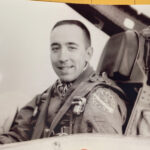2022 Honoree
U.S. Air Force
Vietnam
Thales A. Derrick, better known as “Tad”, was born in 1935, reared in Salt Lake City, Utah, and attended the University of Utah where he joined the ROTC. After visiting an Air Force Training base and experiencing his first flight, he knew he would be a pilot. Derrick joined the Air Force, became an Aviation Cadet, and completed officer’s training and his flight training simultaneously while holding the highest military position awarded to a Cadet, the Aviation Cadet Group Commander.
During his Advanced Fighter Pilot training, he quickly became a combat ready pilot in the F-85F Saberjet, followed by the F-100D Super Sabre and became air refueling qualified. Derrick excelled in three separate fighter squadrons leading him to be selected as an instructor in the F-100C/F.
In 1965, during the Vietnam Conflict, Derrick flew from the Tan Son Nhut Air Base located near Saigon, in South Vietnam and completed 129 combat missions in a F-100. While on a mission, his plane was hit by enemy ground fire hitting both drop tanks and the wing (which was also a fuel tank). Rather than eject, he managed to continue flying the plane as fuel was streaming out of the wing at an alarming rate. Relying on his skills, his wingman, and pure determination, he landed the plane unscathed.
The 481st Tactical Fighter Squadron pilots flew 4,500 combat hours, and 3,200 combat missions in a five-month period. This caught the eye of the South Vietnamese Vice President, a general and former fighter pilot. In appreciation of the 481st dedication toward assisting with the prevention of communist expansion, the Vice President hosted a party for the 481st on their final night in South Vietnam; except for two members of the squadron that would be on duty for night alerts. That evening, Capt. Derrick and his volunteer wingman, Major Berry found themselves on a mission to save a U.S. Military convoy ambushed by a Viet Cong patrol. In the dark of night, no lights on the plane, only by the light of flares they had dropped from their planes, Derrick and his wingman, one coming from the east toward the other coming from the west, dropped their munitions, and saved the convoy. When asked why he chose to take the final night alerts, Derrick said “He would not schedule someone to fly a mission he would not fly himself and he wanted to make sure those of lower ranks made it home to their families.”
After Derrick was promoted to Lieutenant Colonel and at the end of his career, he was selected to chair the worldwide symposium that would completely revise the classified Air Force Manual 3-1 “Fighter Tactics” resulting in six volumes of information and illustrations that are still being utilized by the United States Air Force fighter pilots today.

